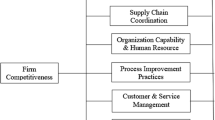Abstract
In a competitive market, a company needs to utilize its available capacity efficiently in order to acquire high profit. The purpose of this paper is to present effective approaches to find a set of product mix optimal for the company to achieve the optimal manufacturing. Analytic hierarchy process (AHP) and analytic network process (ANP) approaches are taken to analyse multiple process inputs and outputs, incorporating experts’ opinion on their priority of importance, to obtain optimal product mixes for semiconductor production. The results provide guidance to the fabricator regarding strategies for accepting orders to maximize the manufacturing efficiency and the profit, while simultaneously considering other important input and output factors for maintaining manufacturing smoothness.
Similar content being viewed by others
References
Alam SS, Shrabonti G (2002) Ranking by AHP: a rough approach. Proceedings of the Fifth International Conference on Information Fusion 1:185–190
Anderson DR, Sweeney DJ, Williams TA (1997) An Introduction to Management Science. West Publishing Company, St Paul, MN
Atherton LF, Atherton RW (1995) Wafer Fabrication: Factory Performance and Analysis. Kluwer Academic Publishers, Boston
Chan FT, Ip RWL (1995) Multi-attribute analysis of flexible manufacturing systems via simulation. Intelligent Systems for the 21st Century. IEEE International Conference on Systems, Man and Cybernetics 2:1327–1332
Cheng EWL, Li H, Ho DCK (2002) Analytic hierarchy process (AHP). Measuring Bus Excell 6(4):33–37
Chou YC, Hong IH (2000) A methodology for product mix planning in semiconductor foundry manufacturing. IEEE Trans Semiconductor Manuf 13(3):278–285
Clemen RT (1996) Making Hard Decisions: An Introduction to Decision Analysis. Duxbury Press, Belmont
Dummler MA (2000) Analysis of the instationary behavior of a wafer fab during product mix changes. Proceedings of the 2000 Winter Simulation Conference 1436–1442
Forgarty DW, Hoffmann TR, Stonebraker PW (1989) Production and Operations Management, Sourth-Western.
Goldratt EM (1990) The Haystack Syndrome. North River Press, Croton-on-Hudson, Great Barrington, MA
Goldratt EM, Cox J (1992) The Goal – A Process of Ongoing Improvement. North River Press, MA
Karsak EE, Sozer S, Alptekin SE (2002) Product planning in quality function deployment using a combined analytic network process and goal programming approach. Comput Ind Eng 44:171–190
Leachman RC, Hodges DA (1996) Benchmarking semiconductor manufacturing. IEEE Trans Semiconductor Manuf 9(2):158–169
Lee JW, Kim SH (2000) Using analytic network process and goal programming for interdependent information system project selection. Comput Oper Res 27:367–382
Little JDC (1961) A proof for the queueing formula L=λW. Oper Res 9:383–387
Luebbe R, Finch B (1992) Theory of constraints and linear programming: a comparison. Int J Manuf Res 30:1471–1478
Malik A, Sullivan W (1995) Impact of ABC information on product mix and costing decisions. IEEE Transactions on Engineering Management 42(2):171–176
Meade LM, Presley A (2002) R&D project selection using the analytic network process. IEEE Trans Eng Manage 49(1):59–66
Padillo JM, Meyersdorf D, Reshef O (1997) Incorporating manufacturing objectives into the semiconductor facility layout design process: a methodology and selected cases. 1997 IEEE/SEMI Advanced Semiconductor Manufacturing Conference 434–439
Punniyamoorthy M, Ragavan PV (2003) A strategic decision model for the justification of technology selection. Int J Adv Manuf Technol 21:72–78
Saaty TL (1980) The Analytic Hierarchy Process. McGraw–Hill, New York NY
Saaty TL (1994) How to make a decision: the analytic hierarchy process. Interfaces 24(6):19–43
Saaty TL (1996) Decision Making with Dependence and Feedback: The Analytic Network Process. RWS Publications, Pittsburgh
Saaty TL, Takizawa M (1986) Dependence and independence: from linear hierarchies to nonlinear networks. Eur J Oper Res 26: 229–237
Spearman ML, Woodruff DL, Hopp WJ (1990) CONWIP: a pull alternative to kanban. Int J Prod Res 28(5):879–894
Wood SC (1997) Cost and cycle time performance of fabs based on integrated single-wafer processing. IEEE Trans Semiconductor Manuf 10(1):98–111
Yang T, Su CT, Hsu YR (2000) Systematic layout planning: a study on semiconductor wafer fabrication facilities. Int J Oper Manuf Manage 20(11):1360–1372
Yu CS, Li CK (2001) A group decision making fuzzy AHP model and its application to a plant location selection problem. IFSA World Congress and 20th NAFIPS International Conference 1:76–80
Author information
Authors and Affiliations
Corresponding author
Rights and permissions
About this article
Cite this article
Chung, SH., Lee, A. & Pearn, W. Product Mix Optimization for Semiconductor Manufacturing Based on AHP and ANP Analysis. Int J Adv Manuf Technol 25, 1144–1156 (2005). https://doi.org/10.1007/s00170-003-1956-8
Received:
Accepted:
Published:
Issue Date:
DOI: https://doi.org/10.1007/s00170-003-1956-8




